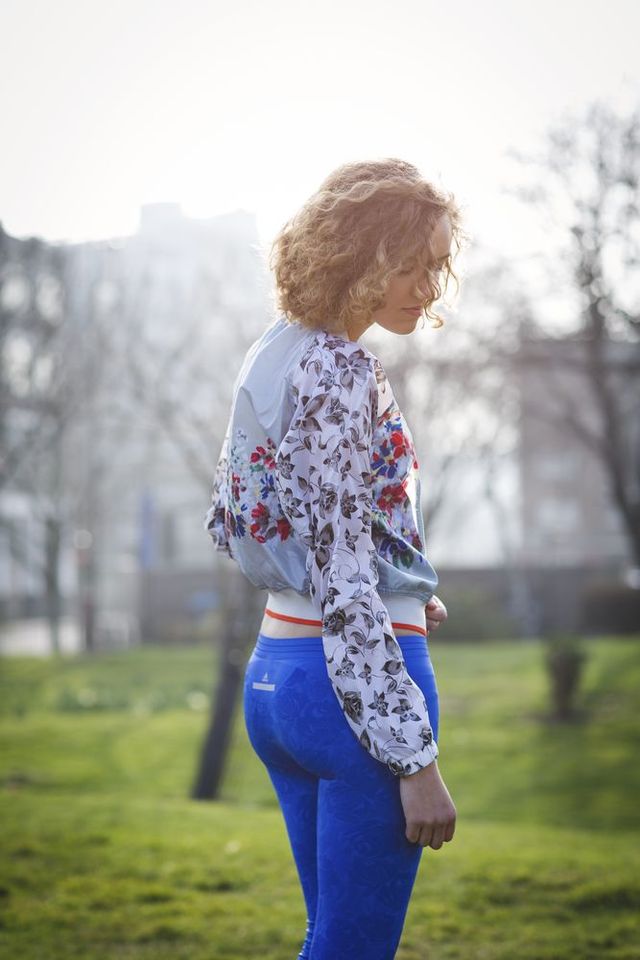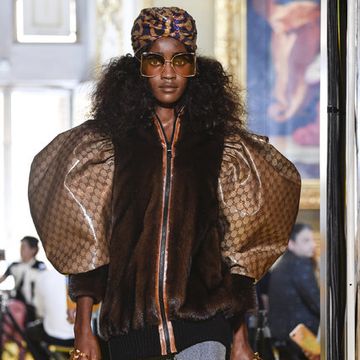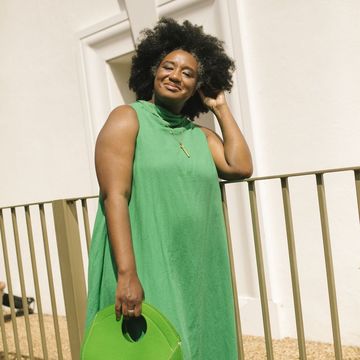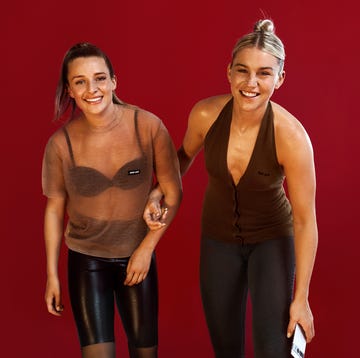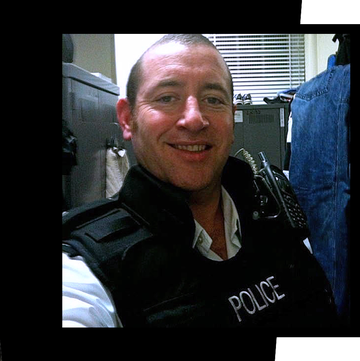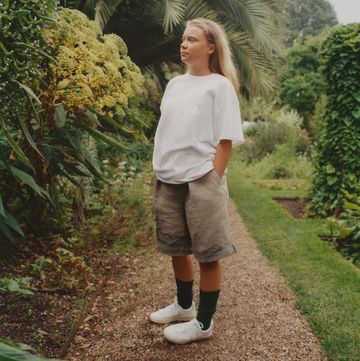I MAKE A LOT OF BIG DECISIONS IN SUPERMARKETS. When I'm just through the automatic doors and the aisles sprawl colourfully ahead of me, while the basket is still light in my hand, that's when I choose who I want to be that week. Some weeks that means piling my basket with fruit and vegetables that are destined for a reinvented, glowing, smoothie-fuelled me. Other days I choose a frugal new life philosophy, scooping clearance bargains, dried pulses and store-cupboard staples into my trolley.
When I was most ill with my eating disorder, which pushed me between depressive bouts of bingeing and purging, and when I cloaked that illness in the respectable guise of 'wellness', I was proud to unload the meagre, mainly green contents of my shopping basket on to the conveyor belt. And when I was ready to start moving beyond the eating disorder, it was against the chaotic backdrop of the supermarket shelves that I began to forge a new me.
I had loved the rules of wellness. No meat, no dairy, no food after 6pm, no caffeine, no junk food, no portion larger than this or that, no fried foods, no eggs. Caught in the dogmatism of wellness and soothed by its promise of happiness, I felt safe from the messy, dangerous world outside. But especially through the warped lens of an eating disorder, that tangle of rules soon started to constrict me as much as it had coddled me.
I HAD BECOME FEARFUL. Food didn't taste the same any more and every bowl of porridge or sliver of lemon meringue pie had only as much value to me as the nutrients it provided and the calories it held. I needed a new rule-free start. So I went to the supermarket and with a big trolley and a long, long list, I set out to face my fears.
Between the moralistic overtones of 'clean eating' and the fear of fatness that permeates our food industry, leaving wellness behind is no easy thing. Luckily though, there's a growing backlash against the kind of disingenuous, even dangerous advice pedalled by self-styled wellness gurus. Belle Gibson, known for her alternative health blog The Whole Pantry, was last year revealed to have lied about her 'clean' diet having cured a cancer that, it turns out, never existed. Hems- ley + Hemsley, the sisters who helped popularise a gluten-free diet through their Channel 4 cooking show, Eating Well With Hemsley + Hemsley, have come under scrutiny for their links to the controversial GAPS diet, which purports to cure illnesses from autism to schizophrenia through a highly restrictive diet. Even former queen of comfort food, Nigella Lawson, has been lambasted for her collusion with the wellness craze in her most recent BBC2 series, Simply Nigella, outraging viewers by showing them how to make avocado on toast.
But even despite the tide turning on wellness, finding a new path is daunting. The rhetoric of clean eating is easy enough to unpick, but the anxiety that those judgements about food – clean, dirty, good, bad, toxic, virtuous and guilty – etch into our psyches are harder to erase. We're made to feel as though food is a minefield, and that nutrition is just about packing as many nutrients into as little substance as possi- ble. We're expected to function with the efficiency of robots, and to feed ourselves in a utilitarian spirit. It's a neurotic, con- flicted food culture that forgets that we are individuals with complex needs, tastes and desires. It's time we put ourselves back in the picture.
Some dietitians, including Michelle Allison of fatnutritionist.com, recommend just this. On her website, you'll find little information about what to eat. There's no ode to chia seeds or evangelism about oats; this type of nutrition is calmer, more measured and less polemic. Rather than dictating what you should eat, the focus is on how you eat: you already have the tools at your disposal to eat what's best for your mind and body. Unless you have a medical justification for a special diet (and that's for a doctor to decide), eating well is as simple as having a varied diet, following your appetite, taking the time to enjoy regular meals and eating what you want, in whatever amounts you choose. Most importantly, it's about eating without fear. When I first set out around the supermarket with that empty trolley, ready to step away from wellness and into my new appetite, I was scared of the freedom. It felt like a descent into lawlessness with no rules to keep me on track, I could put anything in my trolley. If I filled my bags with 'junk', I'd overeat; if I overate, all the order I'd so carefully structured my life with would tumble around me. With excitement, greed and fear curdling in my stomach, I started snaking through the aisles.
I picked up salted crackers and a brick-heavy block of cheddar cheese, two tubs of ice cream and a packet of frozen potato waffles. I slowly gained momentum as I let my cravings take me to the deli counter where a small roast chicken tempted me, and then to a punnet of glistening redcurrants, a fragrant bunch of thyme and a jar of thick, sweet honey. I was surprised at how good it felt. When I was given that freedom, I didn't spiral out of control at all: I felt more empowered and more balanced than ever.
Over the weeks and months that followed, I let that at- titude slowly permeate every part of my diet. I let myself eat chocolate, or soup, or vegetables, or chips, whenever I wanted. I was shocked when, free from the weight of food dos and don'ts, my cravings pulled me just as often to smoothies as they did to the fish and chip shop. When I stopped being scared and allowed myself to eat the food that made me feel good, I felt happier and healthier than ever.
And that joy isn't just a nice perk of a fear-free diet it might even be good for you. In a study conducted in the Seventies, a group of Swedish women were fed a traditional Thai meal of rice and vegetables with fish sauce, chilli and coconut*. The study found that these women – unused to spice, and presumably out of their meat-and-two-veg comfort zone – absorbed significantly less iron from the food than Thai women who ate exactly the same meal. What's more, when the meal was puréed and reduced to nutrition- ally identical though unappealing slop, the Thai women ab- sorbed far less iron than they had when the food had been presented in its usual format. Clearly, enjoying our food makes a difference to how it nourishes us. Add to that the effect of stress on our digestion – curbing our appetites and interrupting our metabolism – and it becomes clear that a rule-free, pleasure-rich diet isn't just a nice idea, it's essential for good health.
I'M STILL NOT 'CURED' OF MY EATING DISORDER, and I don't know if I'll ever be completely free of that anxiety. It revisits me sometimes for days or weeks when my mental health is poor, or when I'm scared, or tired, or sad. But the further I stray from wellness, the more secure I feel in my recovery and the healthier I am in both mind and body. I steer clear of prescriptive diets, rules and scaremongering, I let my appetite take the lead. I fell in love and made some new friends, I cooked for the people I knew and liked, and allowed myself to be nourished by them in turn. When I first cooked for my girlfriend (pancakes with honey and lemon) and made a replica of Matilda's Bruce Bogtrotter chocolate cake for a friend's birth- day, food seemed richer, more joyful and more exciting than ever. This is what it really is to eat well. And it tastes good.
Flavour by Ruby Tandoh (Chatto & Windus, £20) is out now

